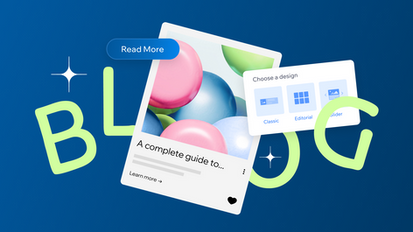Websites Designing Company Trends
Websites Designing Company FAQ
Websites Designing Company
Cooking and baking are not only enjoyable activities, but they can also be a great way to express creativity and share delicious food with others. If you run a food blog or website, building recipes is a crucial part of your content creation. Whether you are a seasoned chef or a home cook, creating enticing and unique recipes can help you attract more visitors to your website and keep them coming back for more. Here are some tips on how to build recipes on your website that will impress your audience and keep them engaged.

Getting Started with Websites Designing Company
Websites Designing Company
Website builders are tools that allow users to create a website without needing to know how to code. They provide pre-designed templates and intuitive drag-and-drop features that make it easy for even the least tech-savvy individuals to create a professional-looking website. With hundreds of website builders available on the market, choosing the best one for your small business can be a daunting task. In this article, we will discuss some of the best website builders for small businesses to help you make an informed decision.
1. Wix
Wix is one of the most popular website builders on the market, and for good reason. It offers a wide range of professionally designed templates that are customizable to suit your business’s branding and style. Wix also has a user-friendly drag-and-drop interface that makes it easy to add text, images, videos, and other elements to your website. In addition, Wix offers a variety of features such as e-commerce functionality, blog integration, and SEO tools to help you optimize your website for search engines.
2. Squarespace
Squarespace is another highly popular website builder known for its sleek and modern templates. It is a great choice for small businesses in creative industries such as design, photography, or fashion, as Squarespace’s templates are visually striking and can be easily customized to showcase your work. Squarespace also offers e-commerce functionality, blogging capabilities, and built-in SEO tools to help you attract more visitors to your website.
3. Weebly
Weebly is a user-friendly website builder that is perfect for small businesses looking to create a professional-looking website quickly and easily. Weebly offers a variety of templates that are fully customizable, along with drag-and-drop functionality that allows you to create a website without any technical expertise. Weebly also provides e-commerce tools, blogging capabilities, and SEO features to help you grow your online presence.
4. Shopify
If your small business is primarily focused on selling products online, Shopify is the website builder for you. Shopify is an e-commerce platform that allows you to create a fully functional online store with ease. It offers a variety of customizable templates specifically designed for e-commerce, along with features such as inventory management, payment processing, and shipping options. Shopify also provides built-in SEO tools to help you attract more customers to your online store.
5. WordPress
WordPress is a powerful content management system that allows you to create a highly customizable website for your small business. While WordPress is more complex than some other website builders, it offers unparalleled flexibility and control over your website’s design and functionality. With thousands of plugins and themes available, you can create a website that perfectly suits your business’s needs. WordPress also provides e-commerce capabilities, blogging features, and SEO tools to help you create a successful online presence.
No code web builders, also known as visual development platforms, are designed to simplify the website creation process by eliminating the need for coding. Instead of writing complex HTML, CSS, and JavaScript code, users can simply drag and drop pre-designed elements, such as text, images, buttons, and forms, onto a canvas to create their desired layout. This intuitive interface makes it easy for users to visualize their website structure and design in real-time, making it ideal for those who are not familiar with coding languages.
One of the key advantages of using a no code web builder is the time and cost savings it offers. Traditional web development projects can be time-consuming and expensive, as they often require hiring a professional web developer or designer to code the website from scratch. With a no code web builder, individuals and businesses can create a website in a fraction of the time and at a fraction of the cost. This makes it an ideal solution for small businesses, startups, and individuals who are looking to establish an online presence quickly and affordably.
Another major benefit of using a no code web builder is the flexibility and customization it offers. With a wide range of pre-designed templates, themes, and modules to choose from, users can easily create a unique and personalized website that reflects their brand identity and vision. Additionally, most no code web builders come equipped with advanced features, such as e-commerce integration, SEO optimization, and mobile responsiveness, allowing users to create a professional-looking website that meets their specific needs and goals.
Furthermore, no code web builders are designed to be user-friendly and accessible to individuals of all skill levels. Whether you are a complete beginner or an experienced web developer, you can easily navigate the platform and create a website that meets your requirements. Most no code web builders come with step-by-step tutorials, customer support, and community forums to assist users in building their websites effectively. This level of support and guidance ensures that users can create a high-quality website without feeling overwhelmed or intimidated by the process.
In addition to their ease of use and cost-effectiveness, no code web builders are also beneficial for maintaining and updating websites in the long run. Traditional websites built with custom code often require ongoing maintenance, updates, and bug fixes, which can be time-consuming and expensive. No code web builders simplify the maintenance process by providing users with intuitive tools for editing, updating, and adding new content to their websites. This eliminates the need for ongoing support from a professional developer, allowing users to manage and maintain their websites independently.
As the demand for easy-to-use website building tools continues to grow, the market for no code web builders has expanded rapidly in recent years. A wide range of platforms, such as Wix, Squarespace, Weebly, and WordPress, offer no code web building solutions that cater to different industries, business sizes, and budgets. Whether you are a small business owner looking to create a simple brochure website or an e-commerce entrepreneur in need of a robust online store, there is a no code web builder available to meet your needs.

Getting Started with Websites Designing Company
Websites Designing Company
In today’s digital age, having a visually appealing and user-friendly website is crucial for the success of any business. A well-designed website can help attract new customers, build credibility, and increase conversion rates. However, designing a website is not as simple as it may seem. It requires a strategic and systematic approach to ensure that the final product meets the needs and expectations of both the business and its target audience. In this article, we will discuss the website design process in detail, outlining the key steps involved in creating a successful website.
Step 1: Define the Purpose and Goals
The first step in the website design process is to clearly define the purpose and goals of the website. This involves identifying the target audience, understanding their needs and preferences, and determining the desired outcomes for the website. For example, is the website meant to generate leads, drive sales, provide information, or showcase products and services? By having a clear understanding of the purpose and goals of the website, you can better tailor the design and content to meet these objectives.
Step 2: Conduct Research
Once the purpose and goals of the website have been defined, the next step is to conduct research. This involves analyzing the competition, researching industry trends, and gathering insights into the preferences and behaviors of the target audience. By conducting thorough research, you can gain a better understanding of what works and what doesn’t in your industry, helping you make informed design decisions.
Step 3: Create a Wireframe
After conducting research, the next step in the website design process is to create a wireframe. A wireframe is a visual representation of the layout and structure of the website, showing the placement of various elements such as navigation menus, headers, footers, and content sections. Creating a wireframe allows you to plan the overall design and functionality of the website before moving on to the visual design phase.
Step 4: Design the Visual Elements
Once the wireframe has been finalized, the next step is to design the visual elements of the website. This involves creating a visually appealing and consistent design that reflects the brand identity and resonates with the target audience. Elements such as color scheme, typography, imagery, and layout are carefully considered to create a cohesive and attractive design that conveys the desired message and engages users.
Step 5: Develop the Website
After the visual design has been approved, the next step is to develop the website. This involves coding the design into a functioning website using HTML, CSS, and other programming languages. During the development phase, the website is tested for functionality, responsiveness, and compatibility across different devices and browsers to ensure a seamless user experience.
Step 6: Test and Optimize
Once the website has been developed, it is essential to test and optimize its performance. This involves conducting usability tests to identify any usability issues, testing load times to ensure fast page speeds, and optimizing the website for search engines to improve visibility and accessibility. By testing and optimizing the website, you can ensure that it meets the needs and expectations of users, leading to better engagement and conversions.
Step 7: Launch and Monitor
The final step in the website design process is to launch the website and monitor its performance. This involves deploying the website to a live server, promoting it to the target audience, and tracking key metrics such as traffic, engagement, and conversions. By monitoring the performance of the website, you can identify areas for improvement and make informed decisions to optimize its effectiveness over time.


